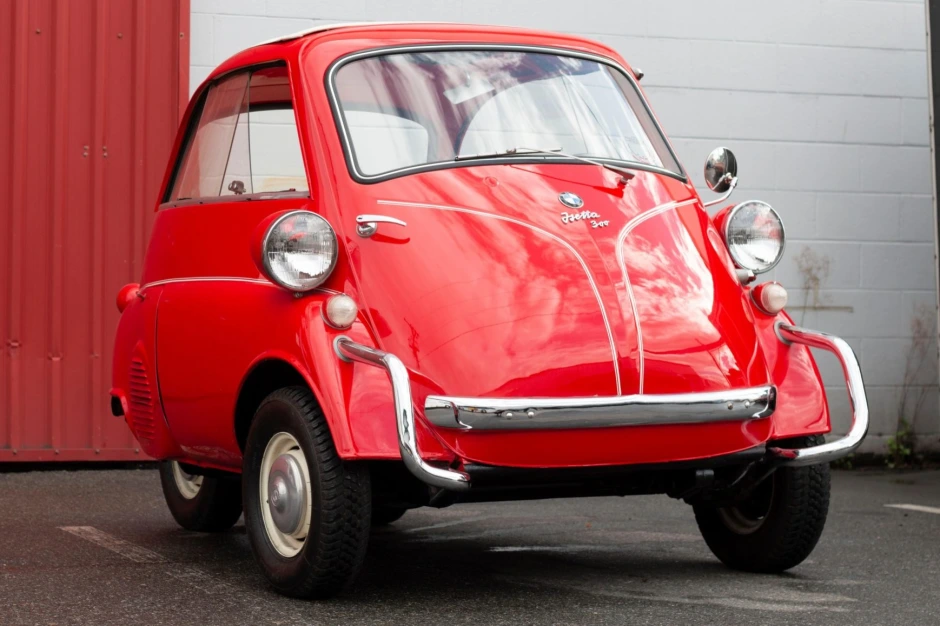
The 1957 BMW Isetta marks a significant point in the history of the automotive industry, especially for BMW. While small in size, the Isetta played a substantial role in shaping the company’s future. It was more than just a car; it was a symbol of the resilience and innovation of the post-World War II era.
History:
The Isetta, originating from the Italian firm Iso SpA, had initially been designed as a practical and economical vehicle solution in the mid-1950s. Recognizing its potential, BMW acquired the license for the design and initiated production in 1955. BMW didn’t merely adopt the Italian design; they refined and transformed it, replacing the original two-stroke engine with their own four-stroke motorcycle engine.
As we move into 1957, the BMW Isetta had not only become a common sight on European roads but was also hailed as the “Miracle on Wheels.” This moniker reflected its significant contribution to the German “economic miracle” or “Wirtschaftswunder.” It was in 1957 that production of the Isetta reached its peak, with BMW further refining the vehicle and expanding its market reach. The Isetta’s popularity was partly due to its affordability and impressive fuel efficiency, which made it an attractive option for the public in a still recovering post-war economy.
Specifications:
Engine: The 1957 BMW Isetta retained the single-cylinder, four-stroke, 247 cc motorcycle engine introduced by BMW. Positioned alongside the rear wheel, this air-cooled engine churned out 12 horsepower at 5800 rpm.
Performance: In terms of speed, the Isetta wasn’t designed to break records. It could achieve a top speed of approximately 85 km/h (53 mph), suitable for the compact cityscapes and short commutes it was intended for. The Isetta’s real strength lay in its fuel efficiency, a factor of immense importance in the 1950s. With fuel consumption estimated at around 3 liters per 100 kilometers, the Isetta was miles ahead of many contemporary vehicles in terms of economy.
Body & Chassis: The egg-shaped Isetta featured a forward-opening door at the front, making it a standout design. Its compact size, measuring 2.29 meters in length and 1.37 meters in width, made it easy to park and maneuver in narrow city streets. Despite its size, the car was designed to seat two people comfortably, offering a cozy interior space.
Suspension & Brakes: The 1957 model continued with the independent front suspension with a leading arm and coil springs. The rear had a semi-elliptical leaf spring. Drum brakes were fitted on all wheels, which, while simple, were quite adequate for the vehicle’s performance parameters and weight.
As the 1950s progressed, the automotive industry was evolving rapidly. The 1957 BMW Isetta, however, stood out among the large, power-hungry vehicles of the era. Its compact design and fuel efficiency made it the ideal vehicle for the financially-conscious consumer, a fact that didn’t go unnoticed by BMW. The German automaker continued refining the Isetta, recognizing the car’s potential to attract a broader audience.
Interestingly, BMW was not the only company to see potential in the Isetta’s design. Iso SpA’s innovative microcar was also licensed to manufacturers in several countries including Brazil, Belgium, France, and the United Kingdom. However, it was BMW that made the most significant modifications to the original design and achieved the most commercial success.
Despite its diminutive size, the Isetta was recognized as a marvel of engineering. BMW’s decision to install a reliable four-stroke motorcycle engine demonstrated the company’s innovative thinking. It offered enough power to propel the car to a modest top speed, making it suitable for city driving and short commutes. But it was the Isetta’s remarkable fuel efficiency that truly set it apart from its contemporaries.
The design of the 1957 BMW Isetta remained distinctive. The front-opening door was a trademark feature, making it unique among other cars of the era. Though this design was initially a result of the compact, economic design, it soon became one of the car’s most endearing qualities. It allowed for easy entry and exit in tight parking spaces, a boon in the increasingly congested European cities.
The Isetta’s bubble-like shape also contributed to its charm and widespread appeal. It was far removed from the traditional car design, yet it was precisely this uniqueness that attracted consumers. Despite its size, the interior was surprisingly comfortable, with enough room to accommodate two adults.
By 1957, the Isetta had proven itself as a resilient contender in the automotive market. It was not just the vehicle’s design and economic operation that drew consumers, but also its symbolic representation. The Isetta was a sign of recovery and resilience in post-war Europe, a symbol of the economic miracle happening in Germany.
Importantly, the Isetta’s success story was a lifesaver for BMW. The company had been on the brink of bankruptcy in the early 1950s, but the Isetta’s sales were instrumental in pulling it back from the precipice. This period in the company’s history is often referred to as the “Isetta era”, underscoring just how important this little car was to BMW’s survival and future growth.
Today, the Isetta is a cherished classic, adored by car enthusiasts around the world. Its unique design, coupled with its significant impact on BMW’s history and its role in post-war European recovery, make it a fascinating piece of automotive history. The 1957 BMW Isetta serves as a reminder that innovation doesn’t always come in the biggest packages and that sometimes, the smallest solutions can have the most significant impact.
